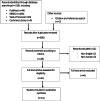Homeobox Genes in Odontogenic Lesions: A Scoping Review
- PMID: 36344906
- PMCID: PMC10063701
- DOI: 10.1007/s12105-022-01481-2
Homeobox Genes in Odontogenic Lesions: A Scoping Review
Abstract
Background: Homeobox genes play crucial roles in tooth morphogenesis and development and thus mutations in homeobox genes cause developmental disorders such as odontogenic lesions. The aim of this scoping review is to identify and compile available data from the literatures on the topic of homeobox gene expression in odontogenic lesions.
Method: An electronic search to collate all the information on studies on homeobox gene expression in odontogenic lesions was carried out in four databases (PubMed, EBSCO host, Web of Science and Cochrane Library) with selected keywords. All papers which reported expression of homeobox genes in odontogenic lesions were considered.
Results: A total of eleven (11) papers describing expression of homeobox genes in odontogenic lesions were identified. Methods of studies included next generation sequencing, microarray analysis, RT-PCR, Western blotting, in situ hybridization, and immunohistochemistry. The homeobox reported in odontogenic lesions includes LHX8 and DLX3 in odontoma; PITX2, MSX1, MSX2, DLX, DLX2, DLX3, DLX4, DLX5, DLX6, ISL1, OCT4 and HOX C in ameloblastoma; OCT4 in adenomatoid odontogenic tumour; PITX2 and MSX2 in primordial odontogenic tumour; PAX9 and BARX1 in odontogenic keratocyst; PITX2, ZEB1 and MEIS2 in ameloblastic carcinoma while there is absence of DLX2, DLX3 and MSX2 in clear cell odontogenic carcinoma.
Conclusions: This paper summarized and reviews the possible link between homeobox gene expression in odontogenic lesions. Based on the current available data, there are insufficient evidence to support any definite role of homeobox gene in odontogenic lesions.
Keywords: Ameloblastic carcinoma; Ameloblastoma; Clear cell odontogenic carcinoma; DLX; Homeobox genes; MSX; Odontogenic tumours; Odontoma; PITX2; Primordial odontogenic tumour.
© 2022. The Author(s), under exclusive licence to Springer Science+Business Media, LLC, part of Springer Nature.
Conflict of interest statement
The Authors declare that there is no conflict of interest.
Figures
References
-
- Balic A, Thesleff I. Chapter Seven - Tissue Interactions Regulating Tooth Development and Renewal, in Current Topics in Developmental Biology, Y. Chai, Editor. 2015, Academic Press. p.157–186. - PubMed
Publication types
MeSH terms
Substances
Grants and funding
LinkOut - more resources
Full Text Sources
Research Materials



